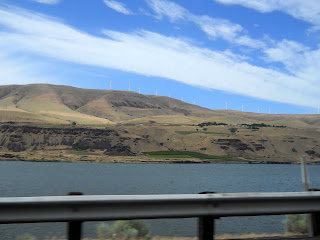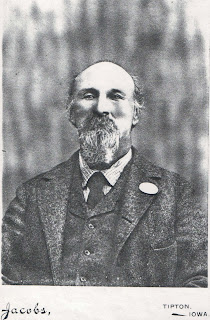Monday, 11 July
Well, we're back home in Salem. After the disappointment in Kalispell we decided to do the final what was planned to be two days in one. We had tentatively planned to try to reach the Zirkle family in Richland, Washington. The McIntosh connection to the Zirkles is through Janet Low McIntosh who married Dean Zimmerman, and many of the Ohio McIntoshes are descendants frin that marriage. I did not have a phone number for them, so I rang for information. There can't be a lot of Zirkles in Richland who are not related to Janet Low McIntosh, so I had high hopes of reaching a cousin there. But all I got was a discrete answering machine, and the message I left inviting them to have dinner with us went unanswered. So there was no reason to take a liesurely two days for the last 475 miles.
So we rose early, went through the now pretty familiar routine of eating and preparing the rig for travel and headed for I-90. This time, however, it was to hell with saving gas; this time we would drive a reckless 65 miles per hour! Whoopee!
The drive through eastern Washington is very interesting. Not so much for its beauty—though it is, but for its geology. At the end of the last glacial period there was a huge lake in the vicinity of what is now Missoula, Montana, formed behind sheet of glacial ice. When the glaciers retreated they released cataclysmic floods across eastern Washington and through what is now the Columbia Gorge. This it did several times over a period of several thousand of years. In western Washington the repeating floods scoured much of the soil from the volcanic base and distributed it in braided patterns of soil and rock. Where the plains of the Midwest are cultivated into seemingly seamless crops of corn and beans. In western eastern Washington, however, the farmer is forced to follow the braided patterns these ancient violent floods left behind.
The effect in the Columbia was even more dramatic because the flood water carrying huge boulders which chiseled a narrow channel through the Cascade Mountains between what is now Oregon and Washington.
Valerie and I felt a bit like we were being hurtled by these ancient flood waters as we bounced along, and I thought to myself, “Since most of the photographs I have taken on this trip have been from the cab of our rig, the final blog would be done that way on purpose rather than by necessity as it had been for the rest of the trip. The only shots that were not taken in this manner were the last two: Multnomah Falls and our home. Multnomah Falls, because it was impossible to see while speeding westward on the freeway, and home, because that is where the trip and the blog end. So fasten your seat belts for the final leg of the journey. And keep in mind that a click on a picture will make it larger.
 |
Scab lands, eastern Washington. Farmer have to work around the rock.
Here there is no working around the rock; the rock has won.
It may be flat here, but there no soil.
It is hard to see in this photograph, but there is cultivation beyond the rock.
Here it looks like the Midwest: cultivation without boundaries.
It is easier to build on the scab lands than it is to plow it.
Sage brush survives in the rocks, barely. The farmer has found good soil in between.
Again, no soil to cultivat; it was washed away during the Missoula Floods.
On the other hand, grapes do well on the rocks, especially chardonnay.
So do apples.
This farmer has figured our to work with his land:
Plant where the soil is.
Now we're in Oregon driving east, driving through the gorge.
The hills are dry on the eastern side of the Cascade Mountains and, in the summer it can be hot -
on both sides of the Columbia River.
 But in the mountains it can be quite cold in the snow. This is Mt. Hood. It is 11,240 and is capped by several glaciers.
But in the mountains it can be quite cold in the snow. This is Mt. Hood. It is 11,240 and is capped by several glaciers.
The gorge is beautiful, but busy. Here a train is next to I-84.
And windmills augment the power generated by the dams. There are 14 dams on the Columbia; we passed 4 on this trip: McNary, John Day, The Dalles, and Bonneville.
On the west side of the Cascade mountains the moist ocean air promotes heavy forestation. On the down side, it means for a fair amount of rain, mostly in the months from November through May.
Multnomah Falls is one of many along the eastern half of the Columbia.
Vista House on Crown Point provides a spectacular view of the gorge and is part of a highway built in the early 1920s. Parts of it are still drivable.
Thanks to all of you who put us up, or just put up with us. We loved seeing you all, and your love and generosity mean a great deal to us.
And now that you know where we live and how easy it is to get around this wonderful land of ours, we hope you will give us the opportunity to repay you by coming to our home. And as you can tell be this picture, the grass is green here, even in the winter.
Much love to all,
Bruce & Valerie
The hills are dry on the eastern side of the Cascade Mountains and, in the summer it can be hot -
on both sides of the Columbia River.
 But in the mountains it can be quite cold in the snow. This is Mt. Hood. It is 11,240 and is capped by several glaciers.
But in the mountains it can be quite cold in the snow. This is Mt. Hood. It is 11,240 and is capped by several glaciers.The gorge is beautiful, but busy. Here a train is next to I-84.
And windmills augment the power generated by the dams. There are 14 dams on the Columbia; we passed 4 on this trip: McNary, John Day, The Dalles, and Bonneville.
On the west side of the Cascade mountains the moist ocean air promotes heavy forestation. On the down side, it means for a fair amount of rain, mostly in the months from November through May.
Multnomah Falls is one of many along the eastern half of the Columbia.
Vista House on Crown Point provides a spectacular view of the gorge and is part of a highway built in the early 1920s. Parts of it are still drivable.
Thanks to all of you who put us up, or just put up with us. We loved seeing you all, and your love and generosity mean a great deal to us.
And now that you know where we live and how easy it is to get around this wonderful land of ours, we hope you will give us the opportunity to repay you by coming to our home. And as you can tell be this picture, the grass is green here, even in the winter.
Much love to all,
Bruce & Valerie















































